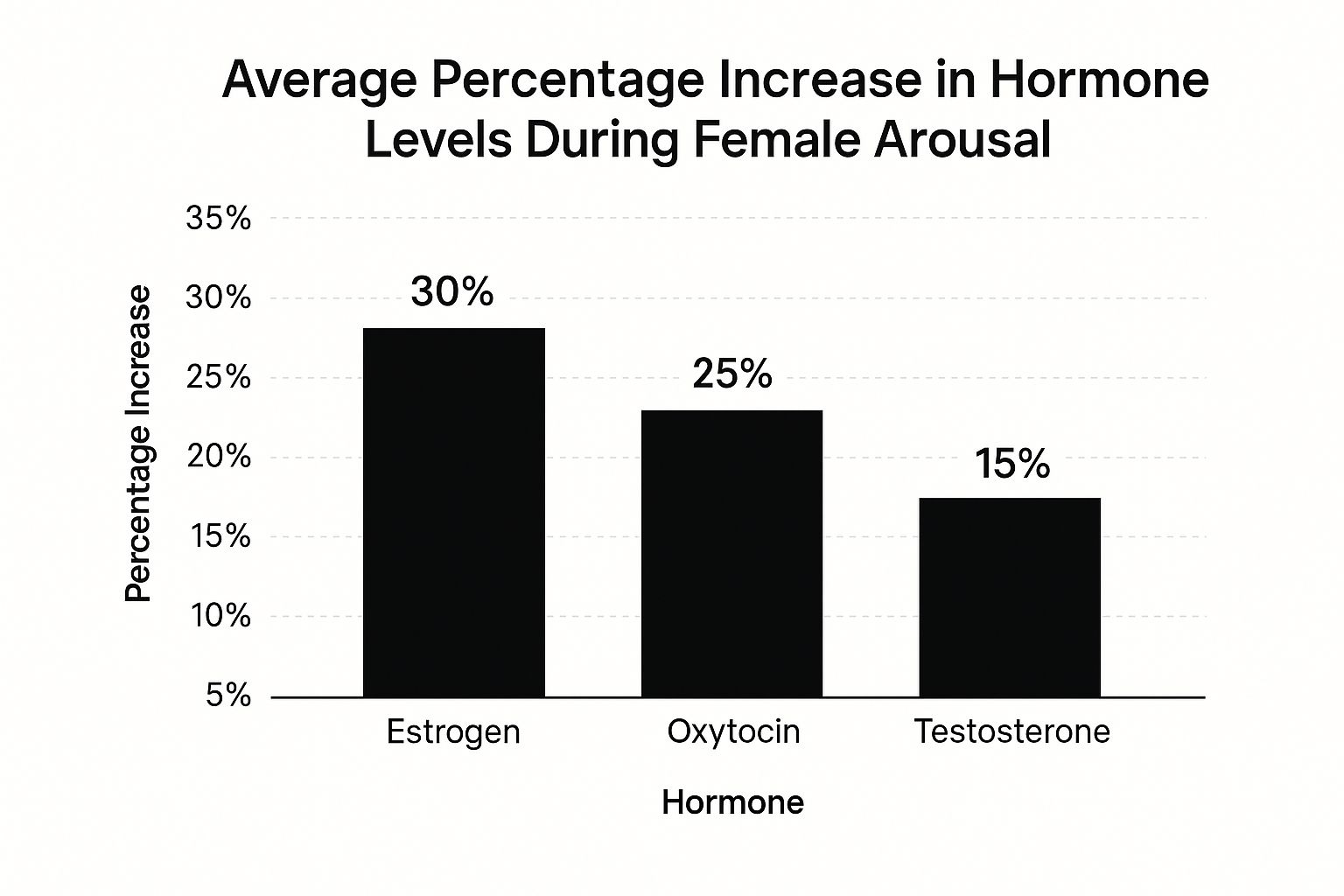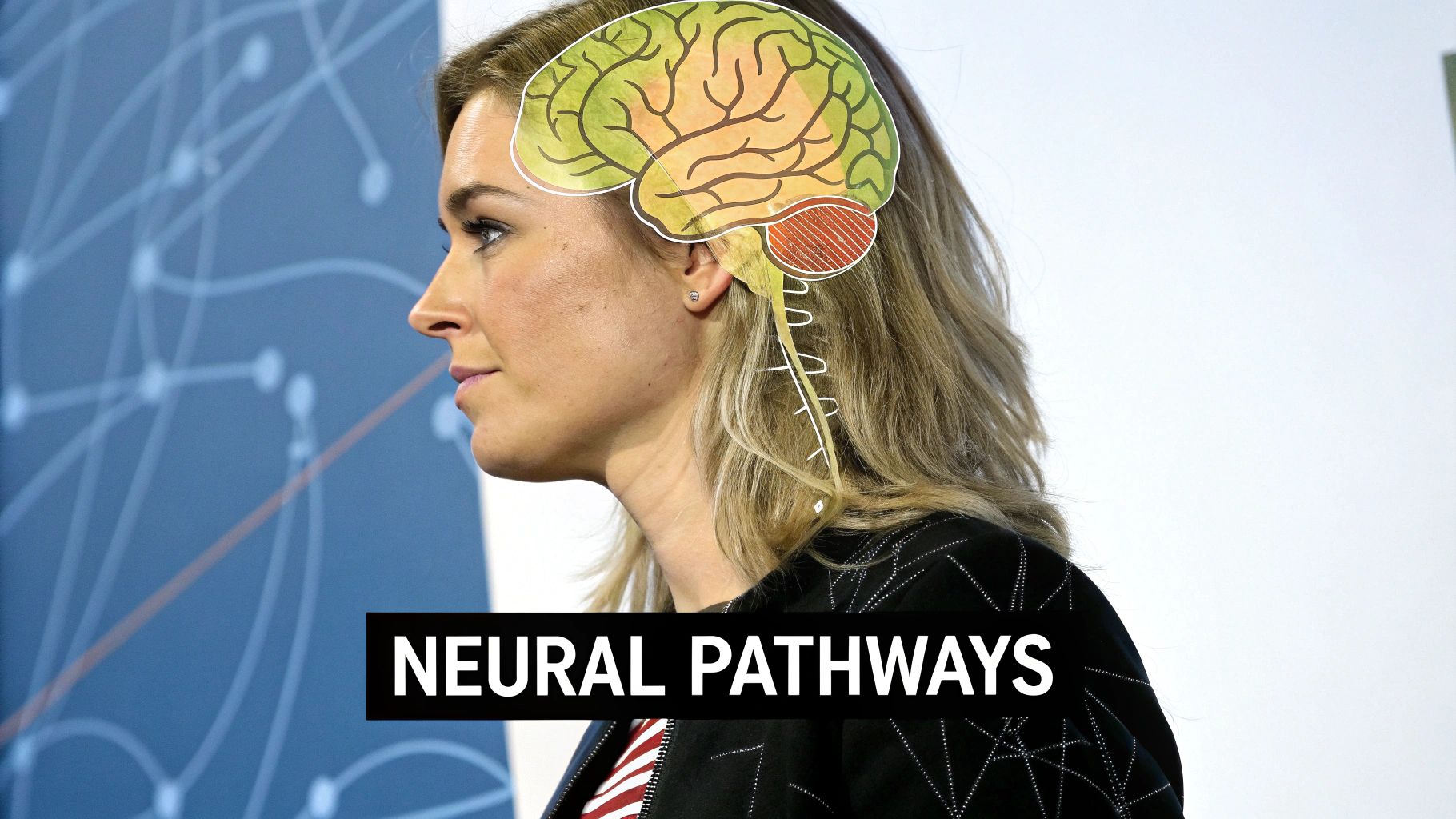Mapping The Physical Foundation of Female Response

Female arousal is a complex process. It involves a fascinating interplay of physical structures and physiological changes. Understanding this anatomy offers valuable insights into how female pleasure works. This means looking closely at the key anatomical parts responsible for sensation.
The Clitoris: More Than Meets the Eye
The clitoris is the primary center for female sexual pleasure. Most people know about the tip (glans) which is externally visible. But the clitoris is much more extensive internally. The crura, sometimes called the “legs,” surround the vaginal opening.
These internal structures are rich in nerve endings. During arousal, they become engorged with blood. This increases sensitivity and contributes significantly to pleasure. The vestibular bulbs, located beneath the labia minora, also engorge, adding to the sensation.
The Vagina and Its Role in Arousal
The vagina also plays a crucial role in arousal, though it doesn’t have as many nerve endings as the clitoris. During sexual stimulation, the vaginal walls become lubricated. This is key for comfortable penetration. The Bartholin’s glands, at the vaginal opening, produce this lubrication.
The front wall of the vagina is also important. It houses the Skene’s glands, sometimes called the female prostate. This area is thought to be particularly sensitive for some women.
The Role of Blood Flow and Muscles
Arousal increases blood flow to the genitals. This results in vasocongestion, the swelling of the clitoris, labia, and vaginal walls. Vasocongestion is essential for heightened sensitivity and pleasurable feelings.
At the same time, pelvic floor muscles contract rhythmically. This contributes to the sensations experienced during orgasm. Research shows hormonal influences on orgasm. Women exposed to lower levels of prenatal androgens may be more likely to achieve orgasm during intercourse. More information on this research can be found here .
These physical responses, combined with psychological and emotional factors, create the complete experience of female arousal. Understanding each element is crucial for appreciating the full spectrum of female sexual response.
How Your Brain Orchestrates Sexual Response
We’ve discussed the physical mechanics of arousal, but the brain’s role in this intricate process is equally vital. It’s the command center, directing the complex sequence of events that culminate in sexual response. This involves a fascinating interplay between different brain regions, neurochemicals, and neural pathways.
The Limbic System: The Emotional Core of Arousal
The limbic system, often called the emotional brain, is key to sexual arousal. This system includes the amygdala and hippocampus, which process emotions, memories, and motivation.
The amygdala analyzes sensory information and triggers emotional responses. The hippocampus connects these sensations with past experiences. This means our emotional state and memories significantly impact our sexual response.
The Sensory Cortex: Interpreting Touch and Sensation
The sensory cortex processes sensory input from the entire body, including the genitals. When these areas are stimulated, the sensory cortex interprets these signals as touch, pressure, and temperature. Specific areas within the sensory cortex are dedicated to processing genital sensations, heightening the feeling of pleasure. You might be interested in: How to master…
The Role of Neurotransmitters: Chemical Messengers of Arousal
Neurotransmitters are essential for relaying signals related to sexual arousal. Dopamine, linked to pleasure and reward, creates feelings of desire and anticipation. Oxytocin, often called the “love hormone,” fosters feelings of bonding and intimacy.
These neurotransmitters, along with others, contribute to the emotional and physical aspects of sexual response. Advanced imaging techniques, like blood-level-dependent functional magnetic resonance imaging (BOLD fMRI), are being used to study brain activity during female sexual arousal. Learn more about the neurological and physiological aspects of female arousal here.
Individual Variations in Brain Response
Every woman’s brain is unique. The neural pathways involved in sexual response can differ significantly between individuals. This explains why different women may react differently to similar stimuli. Individual differences in brain activity, neurotransmitter levels, and past experiences contribute to the uniqueness of each woman’s sexual response.
Hormonal Shifts That Shape Sexual Response Through Life
Your hormones play a crucial role in your sexual response throughout life. From puberty’s onset to the transition of menopause, these hormonal fluctuations create a dynamic experience of sexuality. Understanding this interplay can empower you to better understand the natural variations in your own body’s response.
The Menstrual Cycle’s Influence
Throughout the menstrual cycle, levels of estrogen and progesterone rise and fall. These shifts can influence your desire, arousal, and overall sensitivity. Some women report a heightened desire around ovulation when estrogen is at its peak. Others may experience increased sensitivity or even discomfort during certain phases. These fluctuations are perfectly normal.
Pregnancy and Postpartum: A Time of Transition
Pregnancy brings significant hormonal changes. Increased estrogen and progesterone can increase blood flow to the genitals, sometimes leading to heightened sensitivity. Other factors, such as nausea or fatigue, can affect desire. Postpartum, hormone levels decrease, and the body’s physical recovery can also influence sexual response.
Menopause and Beyond
During menopause, estrogen levels decline. This can lead to changes in vaginal tissues, such as decreased lubrication and elasticity. These changes can sometimes make intercourse uncomfortable. Declining testosterone levels, while less dramatic than the estrogen decline, can also influence desire.
The following infographic visualizes how estrogen, oxytocin, and testosterone levels increase during arousal.  As the infographic demonstrates, estrogen experiences the most significant percentage increase at 30%, followed by oxytocin at 25%, and then testosterone at 15%. This highlights the important role estrogen plays in the physiological response to arousal.
As the infographic demonstrates, estrogen experiences the most significant percentage increase at 30%, followed by oxytocin at 25%, and then testosterone at 15%. This highlights the important role estrogen plays in the physiological response to arousal.
Hormonal Contraceptives and Medications
Hormonal contraceptives, such as birth control pills, can also affect sexual response. Some women report a decreased libido, while others experience no change. Experiences vary depending on the individual and the type of contraceptive used. Other medications, including some antidepressants, can also have sexual side effects.
To understand how these medications may affect you, consult with your doctor or a trusted healthcare professional. Open communication with your healthcare provider can help you navigate these complexities and find solutions that work best for you.
Understanding Your Individual Hormonal Landscape
It’s important to remember that hormonal influences on sexual response are complex and highly individualized. While some general patterns exist, each woman experiences these shifts differently.
The table below outlines hormonal changes and their impact on sexual response across different life stages. This information is for general knowledge and does not replace personalized medical advice.
| Life Stage | Dominant Hormones | Arousal Characteristics | Common Changes |
|---|---|---|---|
| Puberty | Increasing Estrogen & Progesterone | Developing sensitivity, first experiences with arousal | Fluctuating desire, exploring sexuality |
| Menstrual Cycle | Fluctuating Estrogen & Progesterone | Changes in sensitivity and desire throughout cycle | Heightened desire around ovulation for some, discomfort during certain phases for others |
| Pregnancy | High Estrogen & Progesterone | Increased blood flow to genitals, potential heightened sensitivity | Fluctuating desire due to other factors like nausea and fatigue |
| Postpartum | Decreasing Estrogen & Progesterone | Lower hormone levels | Physical recovery and hormonal shifts influence response |
| Menopause | Decreasing Estrogen & Testosterone | Changes in vaginal tissues (decreased lubrication and elasticity) | Potential discomfort during intercourse, potential decrease in desire |
Understanding the hormonal landscape and how it affects your body can help you navigate your sexual health journey. This knowledge can help you determine when changes might warrant a conversation with a healthcare provider. Remember, open communication with your healthcare provider is key to addressing any concerns and ensuring your overall well-being.
Understanding Sexual Challenges Without Shame

Sexual difficulties are a common experience for many women. Instead of feeling ashamed, understanding these challenges is the first step towards finding solutions and improved well-being. This begins with recognizing the different types of sexual dysfunction and their potential causes. Openly acknowledging these issues is essential for creating a supportive environment and seeking help.
Types of Female Sexual Dysfunction
Several types of sexual dysfunction can affect women. Female sexual interest/arousal disorder is characterized by a reduced or absent interest in sex, along with difficulty becoming aroused. Female orgasmic disorder involves challenges in reaching orgasm or experiencing a decrease in orgasmic intensity. Pain during intercourse or difficulties with vaginal penetration are the hallmarks of genito-pelvic pain/penetration disorder. These conditions can arise from a combination of factors, which underscores the importance of recognizing and addressing the problem.
To understand the prevalence of these different types of dysfunction, let’s take a look at the following table:
Types and Prevalence of Female Sexual Dysfunction
Statistical breakdown of different types of sexual dysfunction and their frequency in the female population
| Type of Dysfunction | Prevalence Rate | Primary Symptoms | Age Group Most Affected |
|---|---|---|---|
| Female Sexual Interest/Arousal Disorder | 10-40% | Lack of interest in sex, difficulty with arousal | Can affect women of all ages, but more common in older women |
| Female Orgasmic Disorder | 10-20% | Difficulty or inability to reach orgasm | Can affect women of all ages |
| Genito-Pelvic Pain/Penetration Disorder | 15-20% | Pain during intercourse, difficulty with penetration | Can affect women of all ages, but more common in younger women |
Note: These prevalence rates are estimates and can vary based on different studies and populations.
As this data demonstrates, female sexual dysfunction is widespread and encompasses a range of experiences. This knowledge helps to normalize these challenges and encourages women to seek support.
Physical and Psychological Factors
Sexual challenges can be influenced by both physical and psychological factors. Physical factors might include underlying medical conditions like diabetes or heart disease, hormonal changes, or medication side effects. Psychological factors, such as stress, anxiety, depression, relationship difficulties, and past trauma, can also significantly impact sexual function. Understanding the anatomy of female arousal can provide a more complete perspective on these issues and help identify potential physical causes.
The Importance of Seeking Support
Addressing sexual challenges often requires a multi-faceted approach. Lifestyle changes, such as improving diet and exercise, managing stress, and enhancing communication with partners, can be beneficial. Why Can’t I Orgasm? Tips for Women offers further helpful advice. Therapy or counseling can be invaluable for addressing psychological factors, while medical interventions may be necessary for physical causes.
Approximately 43% of women in the U.S. experience some form of sexual dysfunction, compared to 31% of men (Source ). Seeking support from a healthcare professional or therapist specializing in sexual health is crucial for personalized guidance and treatment. Open communication about these challenges empowers women to take control of their sexual health and pursue the support they deserve. Understanding the anatomy of female arousal can also empower women to better understand their bodies and advocate for their needs in healthcare settings. This knowledge facilitates productive conversations with healthcare providers and therapists, potentially leading to improved sexual well-being. Remember, experiencing sexual difficulties is not a source of shame; these are common issues that can be effectively addressed with the right information and support.
Celebrating The Spectrum of Normal Sexual Response
There’s no single “right” way to experience female arousal. Understanding this is fundamentally important. Each woman’s sexual response is unique, shaped by genetics, experiences, culture, and personal preferences. This section celebrates this diversity and empowers you to embrace your own individual journey.
The Wide Range of Normal
The spectrum of normal sexual response is incredibly broad. Some women experience arousal quickly and intensely, while others experience it more gradually. Some women are aroused by certain types of stimulation, while others have different preferences. Even the experience of climax varies significantly. This variability is not a sign of dysfunction, but a reflection of the complexity of female sexuality. Read also: All About Female Orgasms and the Clitoris .
Embracing Your Individuality
It’s crucial to avoid comparing yourself to unrealistic standards or societal expectations. Your arousal pattern is your own. There’s no need to judge it or conform to a specific template. Understanding the anatomy of female arousal is key to appreciating this individuality. The clitoris, often considered the epicenter of female pleasure, has internal structures extending throughout the pelvic region, influencing response in diverse ways.
Timing and Intensity: Variations in Arousal
The timing and intensity of arousal can fluctuate greatly. Some women experience an immediate surge of arousal, while others require more sustained stimulation. Stress, fatigue, and emotional state can influence these fluctuations. This variation is perfectly normal. Understanding the role of the Skene’s glands, also known as the female prostate, can offer insights into individual sensitivity and response patterns.
The Many Paths to Climax
Just as arousal experiences vary, so do the ways women experience climax. Some women experience intense, focused orgasms, while others experience more diffuse sensations. Some women experience multiple orgasms, while others find satisfaction in other aspects of sexual intimacy. This range is entirely natural. For those struggling with sexual health challenges, understanding available resources is key. Exploring options like compliance automation tools might offer helpful solutions.
Healthy Variation vs. Concerning Symptoms
While variation is normal, it’s important to recognize when changes might warrant professional attention. Significant decreases in desire or arousal, persistent pain during intercourse, or an inability to achieve orgasm despite adequate stimulation can be signs of underlying issues. Consulting with a healthcare provider or therapist specializing in sexual health can provide guidance and support. Recognizing the difference between healthy variation and potential concerns helps you appreciate your individual response while also knowing when to seek professional guidance.
Applying Science to Enhance Your Sexual Health

Understanding the anatomy of female arousal goes beyond textbook knowledge. It empowers you to take control of your sexual health and find greater satisfaction. This section bridges the gap between theory and practice, offering practical insights to improve your sexual well-being.
Lifestyle Factors for Healthy Sexual Function
Several lifestyle choices can significantly influence your sexual response. Regular exercise, for instance, boosts circulation, which is crucial for the vasocongestion process behind arousal.
A balanced diet also plays a vital role. It nourishes the nervous system and helps maintain hormonal balance, both essential for healthy sexual function.
Managing stress is equally important. Techniques like mindfulness or meditation can minimize stress’s negative effects on desire and arousal.
Finally, prioritizing sleep allows your body to recover and regulate hormone levels, further supporting optimal sexual health. These lifestyle adjustments lay the groundwork for a more fulfilling sex life.
Communication: The Key to Intimacy
Open communication with your partner is essential. Talking openly about your needs, desires, and preferences fosters trust and understanding, leading to greater intimacy and sexual satisfaction.
This involves discussing what feels pleasurable, what doesn’t, and any concerns or anxieties you might have. Honest communication creates a safe and supportive space for exploration and mutual pleasure.
This connection can deepen your emotional bond and enhance the overall sexual experience.
Seeking Professional Help: Knowing When and How
Sometimes, lifestyle changes and communication alone are not enough. If you face persistent sexual challenges, seeking professional help is a sign of strength.
A healthcare provider can identify any underlying medical conditions and provide personalized guidance. Therapists specializing in sexual health can help you address psychological factors, relationship dynamics, and past experiences that may be affecting your sexual well-being.
Knowing when to seek help is crucial for addressing any underlying issues.
Treatment Options and Advocating for Your Needs
Various treatment options are available for sexual dysfunction, ranging from medication to therapy. It’s essential to advocate for your needs within healthcare settings.
This means asking questions, voicing your concerns, and actively participating in decisions regarding your treatment. Understanding the anatomy of female arousal equips you to have informed discussions with healthcare providers.
This empowers you to communicate your experiences effectively and advocate for the appropriate care. Don’t hesitate to seek second opinions or explore different treatment approaches until you find the best fit for you. Your sexual health is a vital part of your overall well-being, and you deserve to have your concerns addressed with respect and compassion.
Key Takeaways For Understanding Your Sexual Response
Your essential guide to remembering and applying what matters most about female arousal anatomy. These research-backed insights will help you better understand your body, reduce anxiety about sexual response, and make informed decisions about your health. Each takeaway offers practical knowledge you can use immediately, along with guidance on where to find more support and resources for continued learning about sexual health.
Takeaway 1: The Clitoris Is Key
The clitoris is the primary center for female pleasure, extending far beyond the visible tip. Its internal structures, the crura and vestibular bulbs, are essential for arousal and orgasm. Understanding this complex anatomy helps explain why clitoral stimulation is so important for many women.
Takeaway 2: The Brain Orchestrates Arousal
Arousal isn’t solely physical; it’s a complex interplay between the brain and the body. The limbic system processes emotions and memories, while the sensory cortex interprets touch. Neurotransmitters, such as dopamine and oxytocin, contribute to the overall experience. This highlights the connection between physical sensations, emotions, and thoughts during arousal. You can learn more about their focus on science .
Takeaway 3: Hormones Matter
Hormonal fluctuations throughout life, including the menstrual cycle, pregnancy, and menopause, significantly affect sexual response. Estrogen, progesterone, and testosterone all play a role in desire, arousal, and sensitivity. This means your sexual response can naturally change over time.
Takeaway 4: Sexual Challenges Are Normal
Experiencing difficulties with arousal or achieving orgasm is common and nothing to be ashamed of. These challenges can result from physical or psychological factors. Openly discussing these issues is the first step towards finding solutions.
Takeaway 5: Embrace Your Unique Response
There’s no single definition of “normal” when it comes to female sexual response. Every woman experiences arousal and orgasm differently. Embrace your individuality and avoid comparing yourself to others. This self-acceptance promotes confidence and a healthier relationship with your sexuality.
For more detailed information and resources on female sexuality, visit G-Spot 101 .
The post Anatomy of Female Arousal: Science-Backed Guide to Response appeared first on G Spot 101 .
Intimate Tickles found this article quite interested, and we thought you might to. We give all the credit for this article to gspot. Click Here To Read This Article From It's Original Source



